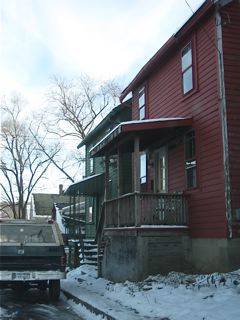Locality: "We have distressed neighborhoods" Conventional Thinking: "We have housing dollars" Locality: "But we have distressed neighborhoods" Conventional Thinking: "But we have housing dollars" Locality: "So?" Conventional Thinking: "You can run organizations with these dollars and keep at it forever" Locality: "So problems don't actually have to be solved?" Conventional Thinking: "Correct"
Locality: "We have distressed neighborhoods"
Conventional Thinking: "We have housing dollars"
Locality: "But we have distressed neighborhoods"
Conventional Thinking: "But we have housing dollars"
Locality: "So?"
Conventional Thinking: "You can run organizations with these dollars and keep at it forever"
Locality: "So problems don't actually have to be solved?"
Conventional Thinking: "Correct"

Resistance to change comes in many forms. Common is work avoidance. Other forms include placing one's head in the sand. Still another is ignoring reality. And a dangerous form of this is continuing to do what has always been done, yet expecting a different outcome. Per the 'junk in-junk out' concerns expressed recently about the manner in which $3.92B of taxpayer proceeds are now headed to states and cities to address the foreclosure and attendant subprime mess, what is happening in large and small ways across the country are forms of resistance to the changes needed in the community field.
The field has learned the lingo: logic models, healthy neighborhoods, submarkets; but they have not adopted them. You see this in the NSP dialogue on line, and between cities and states. You see it in RFPs where cities state they are looking to hire a team to help them "revitalize a neighborhood". But when you unpack the RFP, and talk to the city officials who wrote it, or when you are part of the dialogue between cities and states trying to craft responses to the NSP funds on the street, what you hear is the 'song' behind the words, and the song is quite different.
The words say "logic model" but the song is all about activities and units and volume. There is no deep grasp of outcomes. The words say "healthy neighborhoods" but the song is all about being seeing all soft neighborhood problems as housing shortages. The words proclaim "stabilization" but the song is all about appearing to be responsive when in fact it would take and NSP ten times its actual size to make a difference.
The forces that keep our field from moving forward are substantial. The suburbs and suburban development paradigms aren't willing or equipped to absorb mixed-income housing, let alone mixed-income rental housing for minority households. City councils are responsive to areas where people vote, and will have no part of a reasonable discussion about fair share, never mind that the facts indicate terrible futures for places consigned to economic segregation year after year. Low-income areas are afraid of not having a low-income neighborhood next decade. The response system of weak and ineffectual community based organizations needs operating capital it can't get anywhere but from overly squeezed deals that by design will never mark to a healthy market. Together, its a perfect system for keeping the lid on the truth that our community development field as is is broken, conventional community planning processes as is are not hardwired to push communities to wrestle with hard truths, mobilizing residents is not part of the skillset, and many a local housing authority is more rewarded by the volume of vouchers they can have control over than by how many poor people they help become unpoor. Are there exceptions? Sure. But they are very rare.
As new NSP plans and funding becomes actualized, watch closely to see which localities are genuinely stepping up to the times, deploying the lessons we have now about dangerous concentrations of poverty, and changing the way business is done. Watch to see which organizations want to keep things the same, which try to change, and which perniciously say they are changing but in reality are not.
Come early January, we'll have a good idea of who in America genuinely wants a new kind of community development (given the facts and the merciless reality of history), and who used December 2008 as a month to actually stabilize neighborhoods rather than define our current crises as a housing shortage problem.

Planetizen Federal Action Tracker
A weekly monitor of how Trump’s orders and actions are impacting planners and planning in America.

Map: Where Senate Republicans Want to Sell Your Public Lands
For public land advocates, the Senate Republicans’ proposal to sell millions of acres of public land in the West is “the biggest fight of their careers.”

Restaurant Patios Were a Pandemic Win — Why Were They so Hard to Keep?
Social distancing requirements and changes in travel patterns prompted cities to pilot new uses for street and sidewalk space. Then it got complicated.

Platform Pilsner: Vancouver Transit Agency Releases... a Beer?
TransLink will receive a portion of every sale of the four-pack.

Toronto Weighs Cheaper Transit, Parking Hikes for Major Events
Special event rates would take effect during large festivals, sports games and concerts to ‘discourage driving, manage congestion and free up space for transit.”

Berlin to Consider Car-Free Zone Larger Than Manhattan
The area bound by the 22-mile Ringbahn would still allow 12 uses of a private automobile per year per person, and several other exemptions.
Urban Design for Planners 1: Software Tools
This six-course series explores essential urban design concepts using open source software and equips planners with the tools they need to participate fully in the urban design process.
Planning for Universal Design
Learn the tools for implementing Universal Design in planning regulations.
Heyer Gruel & Associates PA
JM Goldson LLC
Custer County Colorado
City of Camden Redevelopment Agency
City of Astoria
Transportation Research & Education Center (TREC) at Portland State University
Camden Redevelopment Agency
City of Claremont
Municipality of Princeton (NJ)



























